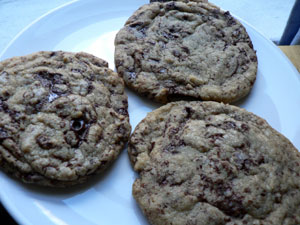 At last, cookies
At last, cookies
I decided long ago that I wanted to produce excellent chocolate chip cookies, and the helpful advice poured in. Wednesday pointed me to a recipe at Wordstoeatby, and I gave that a try in the middle of winter. I was pleased with the result, but I tried twice since then and failed completely both times.
There were several problems with these attempts:
- I was halving the recipe because I had just one baking sheet. Mom told me that wasn’t necessary, and that I could just bake the cookies in two batches.
- I didn’t have the right equipment. It’s hard to mix cookie dough with no stand or hand mixer. I also had really hard brown sugar, since this was in the dark days before I bought a brown-sugar saver. Poor Nathan would slave away with a wooden spoon trying to cream rock-hard sugar with cold, cubed butter.
- I didn’t know the difference between “t” and “T” in an ingredient list. Mom, how did this happen? How did I grow up where I grew up, and now work where I work, without knowing this? Nathan thought it was common knowledge. So I may have used a tablespoon of baking soda instead of a teaspoon the last time I tried.
It’s so much easier to make something when you have everything you need. I’m still lacking a second baking sheet, a cooling rack, and a cookie scoop, but I made do this morning, and these cookies are better than ever.

It can be hard to live by recipes when you have a kitchen as small as ours. There is no room for a stand mixer, no room for almond flour, no huge cabinets into which I can put a waffle iron and a couscoussière, no basement for an ice cream maker. I have a few drawers and a few shelves, and I try not to waste one square inch of them. If I don’t use it, I put it in the hall or throw it away.
I opened Martha Stewart’s new baking book last night, looking for a recipe in which to use the eight ounces of Valrhona bittersweet I picked up. Every recipe in there asked for some ingredient or piece of equipment I don’t have. I suppose if you bake all the time, you just have these things and find space for them. But I bake less often than once a month, and this isn’t likely to change. I wish more recipes would say, “Ok, if you don’t have this, use this. If you don’t have this size dish, change the recipe in this way and use this size.” With savory dishes like stews, it’s so much easier to make substitutions; as long as you have water, salt, and fat, you can fudge it. Not so with baking, at least as far as I can tell with my dearth of experience.

Comments
It can be frustrating to cook in less than ideal circumstances. I’m going to run into that soon when the kitchen is being worked on. I don’t know yet what restrictions I’ll have, but I may not have a stove or cooktop for awhile. Fortunately I was raised by a mother who has a pioneer spirit and passed some of it on to me, so I’m pretty good at making do in those kinds of circumstances.
Anyway, as far as cooling racks go, I think you have a gas stove—you can pull the grate things off the burners and use them. I’ve done that many times.
There’s a great blog called Cooking for Engineers that has a list of ingredient substitutes that you might find helpful.
Even I am sometimes stumped when recipes call for 16 oz. of pasta or whatever and I have a great big bag. I have a hard time remembering how many cups that is and have to look it up. So I’m not surprised that you never really learned about T./t. You watched me cooking and helped out, but you were following my directions and weren’t actually reading the recipes yourself.
BTW, no one needs a special gizmo to keep brown sugar soft. All you need to do if your brown sugar gets hard is to put a piece of apple in it overnight and it will be soft the next day. Next time ask Mom before you spend your money! :)
My mother does that with gingersnaps because she like them soft rather than crisp.
My special trick for keeping brown sugar soft? Keeping it in the fridge! I can’t remember who told me this, but it totally works. The cool temperature or maybe it’s the humidity, keeps the sugar soft for a Very Long Time.
I agree, there is nothing more frustrating than baking in less than ideal circumstances or lacking the “right” equipment. That can be esp. annoying in our tiny NYC kitchens. I gave up living in a studio to have roommates again in no small part because I knew I’d have a proper-sized kitchen again!
Wow — those are great tips. A few years ago, after making two batches of molasses cookies with two different boxes of brown sugar (one old, one new), I found out what a HUGE difference it makes. And it seems to get hard instantly in my cupboard. I just buy a new box every time I make cookies but I guess now I don’t have to!
Also, I don’t think not having a mixer is a bad thing. As a kid, a family friend’s housekeeper made amazing chocolate chip cookies and her secret was that she did the whole thing by hand. And the recipe that you link to suggests using the mixer on low speed, so maybe that’s similar to mixing by hand?
Did you find a recipe? There was one in the Post-Gazette this weekend that looks pretty simple (if you have a thermometer)
CHOCOLATE MOUSSE
This cool and creamy classic French dessert is the perfect end to a summer meal, especially since it means you don’t have to turn on your oven. Use your favorite bittersweet chocolate here; some premium brands, with a higher percentage of cocoa solids, will result in a slightly denser mousse.
2 cups very cold heavy cream
4 large egg yolks
3 tablespoons sugar
Pinch of salt
1 teaspoon vanilla extract
7 ounces good bittersweet chocolate (not unsweetened), chopped
Lightly sweetened whipped cream
Heat 3/4 cup cream in a 1-quart heavy saucepan until hot but not boiling; remove from heat. Whisk together yolks, sugar and salt in a metal bowl until well combined, then add hot cream in a slow stream, whisking until combined. Transfer mixture to saucepan and cook over moderately low heat, stirring constantly, until it registers 160 degrees on thermometer. Pour custard through a fine-mesh sieve into a small bowl and stir in vanilla.
Melt chocolate in a large metal bowl set over a pan of barely simmering water, stirring frequently. Whisk custard into chocolate until smooth. Let cool. Beat remaining 1 1/4 cups cream in a large bowl with an electric mixer until it just holds stiff peaks. Whisk one-quarter of the cream into chocolate custard to lighten it, then gently but thoroughly fold in the remaining cream.
Spoon mousse into eight 6-ounce stemmed glasses or ramekins. Refrigerate, covered, for at least six hours. Let mousse stand at room temperature 20 minutes before serving, topped with whipped cream. It can be refrigerated covered for up to 1 day.
Serves 8.
— The Gourmet CookbookA Taste of Chocolate
Abby—your housekeeper could be onto something there, because mixers do whip a lot of air into batter (beat until light and fluffy) and you don’t necessarily want that in a cookie, especially if you want it to be chewy.
OTOH, cookie batters are so heavy that mixing them by hand REALLY makes your arms tired!
Marcy—That is perfect; chocolate mousse is one of Leland’s favorite desserts! I skimmed right over that recipe in the paper and it didn’t even register. Thanks!
It would seem that I have a chance of getting some chocolate mousse on my next trip to Pittsburgh. Thanks, Marcy!
Marcy made that suggestion so you could use your chocolate, Leland! And it was darn nice of her to provide the recipe.
I’m always angling for mommy to make me dessert. Thanks for the recipe, Marcy!
Forgive me, I know this comment is very late, but I also have a couple tips.
A few years ago I was on a baking kick and made a lot of different sweets—cookies included. In addition to going on sugar overload, I found that it’s not too hard to bake without the right “equipment.” I can’t afford a stand mixer, and using a cumbersome hand mixer is too frustrating for me, so I just mixed everything by hand (even now, I mix all my doughs by hand—be it cookie, bread or otherwise). I never found it too tough mixing cookie dough as long as I used softened butter. Not totally room temperature, but not straight out of the fridge. If you press the butter it should give with some resistance, but without cracking. I found cutting up the butter into pieces and letting it sit for a few minutes (maybe 10 or 15 minutes? I’ve never timed it, but it’s not long) helps.
As for the brown sugar, at some point I was told to microwave hard brown sugar for a few seconds to soften it up. And in a pinch, it totally works! It’s bailed me out when I was unwilling to go buy more sugar in the middle of a recipe.
Also, if anyone is having trouble knowing what substitutions to use in baking and cooking (aside from using the internet), try looking at old church and community cookbooks. While I usually don’t turn to them for straight recipes anymore (there’s only so many variations of hamburger casserole one can take), many of them have guides for substitutions, and sometimes if I’m out of something, I’ll check the book before running to the store.
Whew—that was long!
Add a comment